To the people at Netflix who champion Castlevania, THANK YOU. With the flawless art style, perfect voice acting roles, and the ever-expanding universe of characters, this series is one of my favorites on the streaming platform. After the events of season two, that culminated in Alucard finally killing Dracula, the battle at Braila, and Trevor giving Alucard his family land, season three kicks off with multiple storylines that seem to casually weave together in time. Because of the episode count (a whopping ten!!), we’ll be splitting our review and recap into two parts.
After Dracula’s death, the world has not simply fallen back into place. In fact, many people still don’t know about his death. Season three picks up about a month after Trevor and Sypha have left Alucard behind to watch over Dracula’s castle and the Belmont hold. The show branches the plot through four main storylines. It follows Alucard at the castle where he meets two young Japanese vampire hunters named Sumi and Taka, Trevor and Sypha in their journeys and eventual arrival at the small town of Lindenfeld, Hector after his capture by Carmilla and his time spent in Styria, and Isaac as he journies back to Europe with his horde of night beasts to seek vengeance.
One of the things that Castlevania does really well is how easily they weave together the mythology of the world and manage to incite terror and curiosity in a viewer of each episode. We want to know what Carmilla is planning, how the four queens rule Styria, we want to know if Isaac is one step away from simply murdering all humans to turn them into night beasts. The series does good work mixing tones, sometimes dry humor and playful, sometimes serious and dark.

Alucard, Sumi, and Taka
Alucard’s journey is peaceful, at first, if a bit boring. After a month alone, his serene life feels dull compared to his time with Trevor and Sypha. His home is still in shambles. He spends his days alone, fishing for himself and spending his dinners talking to the little dolls that he’s made of Trevor and Sypha. This is a man who is crying out for help. Thankfully, his loneliness is quickly interrupted by the introduction of Sumi and Taka.
I was so glad that they expanded on the character of Cho, who was definitely the most interesting looking vampire to me in Dracula’s war council. The Japanese vampire once had a hidden court in rural Northern Japan, where she kept slaves trapped and executed her will with sadistic delight. Flashbacks show her inviting warriors into her court only to brutally kill them in front of her slaves.
The action sequences in this show can not be beat, I typically hate watching fight choreography simply because I find it boring and often it doesn’t further any plot element. But the art and style of these fights are so perfectly crafted and do so much in revealing characters and are truly riveting to watch. The flashback in which we see Cho at her finest is mesmerizing and beautiful but also horrifically violent. She clearly takes enjoyment from torture and murder. A trait that seems common amongst vampires.
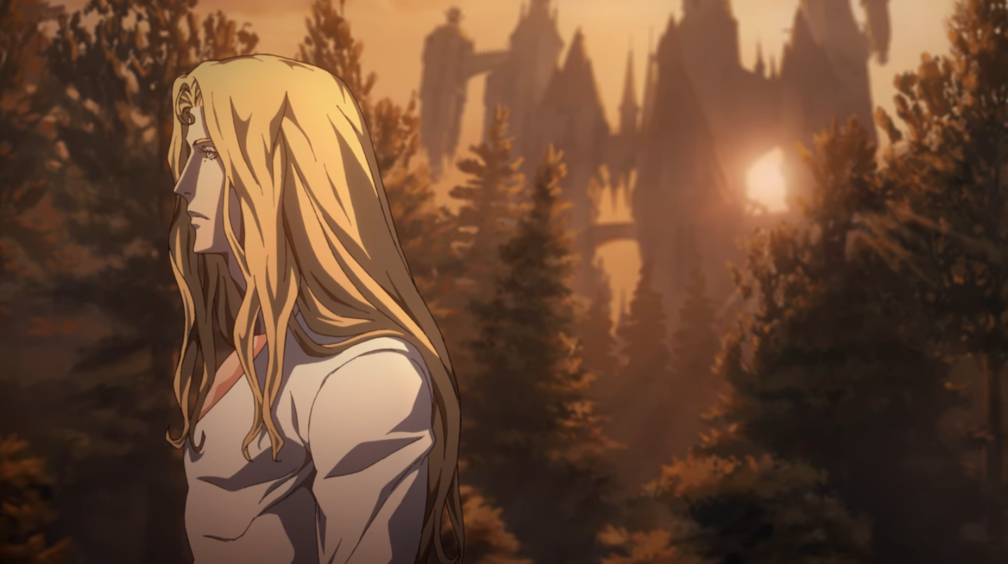
Learning from Cho, Sumi and Taka wasted no time in freeing their people once Cho was called away to Dracula’s war court. They learned to fight and have been determined to destroy Cho and all vampires to prevent their people from ever being enslaved again. Tracking Cho, they arrive at the castle only to meet Alucard and find out that not only is Cho dead, but Dracula is also dead. Still, they want Alucard’s help in training and learning how to fight vampires using both weapons and magic.
While I definitely miss Alucard with Sypha and Trevor, I like his scenes with Sumi and Taka. It not only shows off how skilled Alucard is, but it also expands the story past the boundaries of Europe, and it reveals a potential for Alucard as a teacher. I’m also not super sure about the relationship between the three of them. I can’t tell is Sumi and Taka are just partners, or lovers, or siblings? And I can’t tell if I’m picking up a flirtation with Alucard, or if he views them like children?
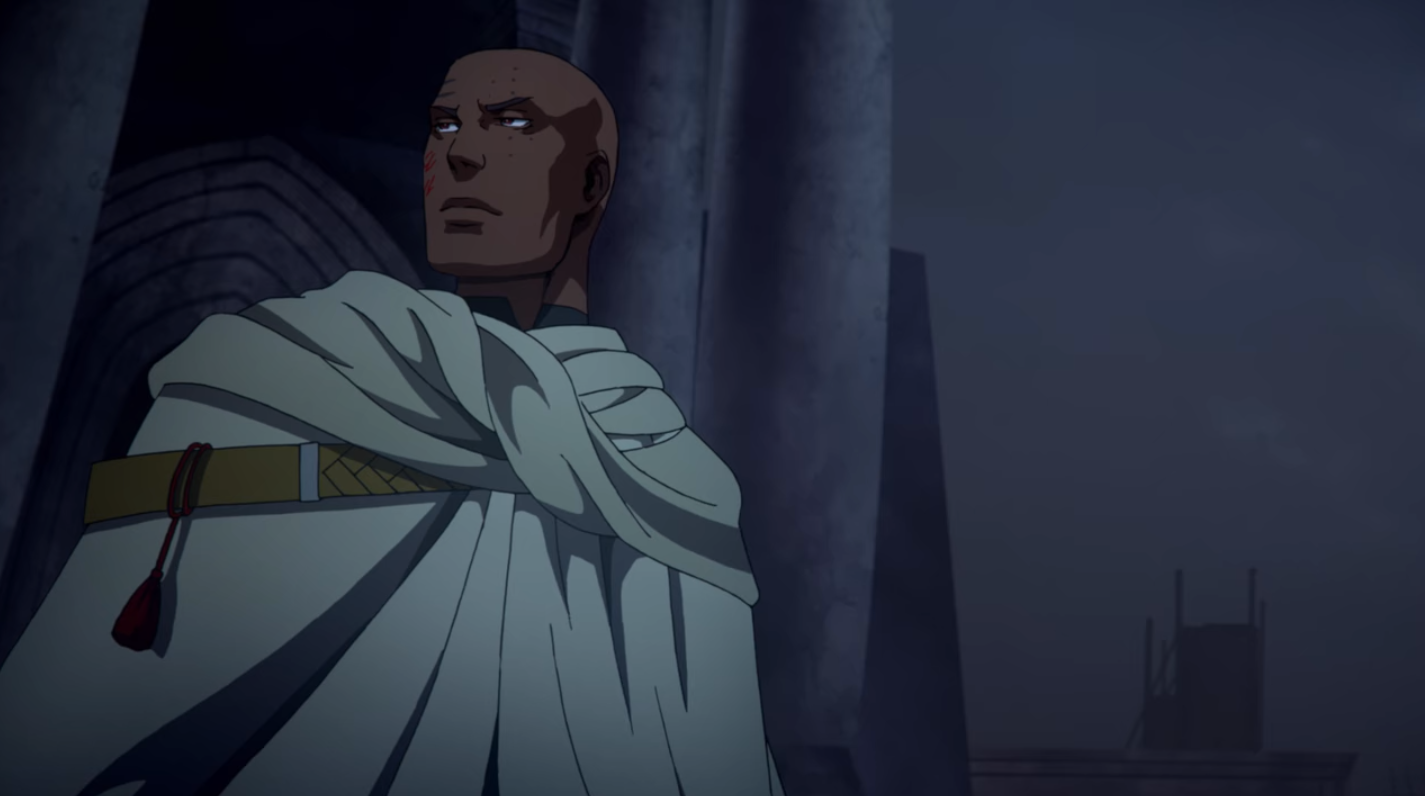
Isaac
Isaac, who was hurtled through a magical mirror into sand dunes by Dracula, has come a long way from drinking water at an oasis alone. He’s used his forge master skills to turn those who oppose him into night creatures. While I find Isaac’s story the most compelling and intriguing, he is my least favorite character. This misanthrope has come a long way from being Dracula’s forge master but not necessarily for the better.
He is followed by a small army of night creatures bent to his will and every town he approaches is terrified by his arrival. He’s been busy since we last saw him, and now his forging knife turns people into night creatures immediately, which is different from the simply necromancy we saw at the end of season two. He explains that forge masters are able to directly pull demons from hell and put them into dead bodies.
Isaac’s main goal is to get vengeance for Hector’s betrayal. He sees Hector’s betrayal as a key reason why Dracula is dead. He finds a collector in Tunis who offers him a distance mirror that allows him to find Hector, who is being held as a prisoner in Styria. He then hires a ship captain to sail him to Genoa so he can exact his revenge.
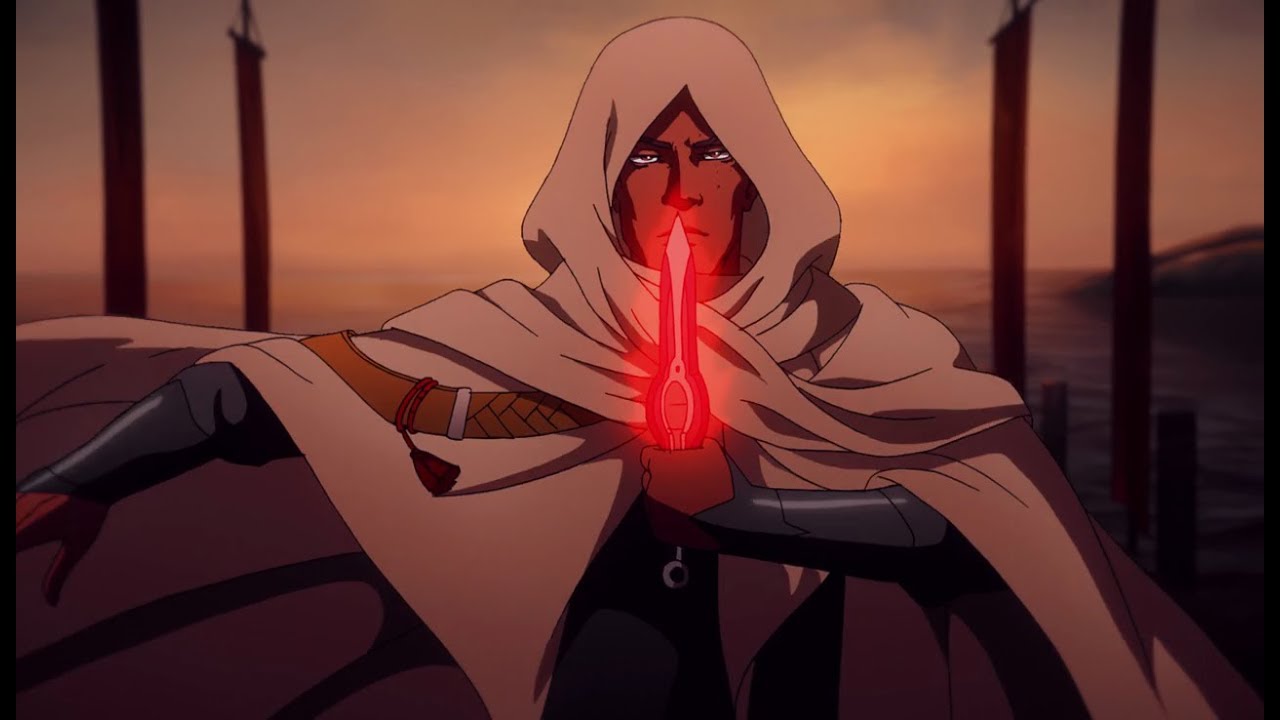
Some of Isaac’s most interesting moments is him wrestling with his own deep hatred of humanity and meeting people who seem to show him enough kindness that it lets him hope. Both the Captain and the collector have a good rapport with Isaac, recognizing that he has been through a lot and has lost someone dear to him. They show him kindness and friendship. But that kindness is not enough for Isaac to forgive the guards who want him out of their town because he travels with night creates.
Isaac’s character seems to think that he poses no threat to those who listen to him, that he is the one being forced to kill and forge more night creatures. But these lands have been terrorized by night creatures and they are literally demons from hell. The attempts to show nuance to Isaac is ambitious and serves to tell a good story, but the extremism of Isaac leaves a lot to be desired. He lacks the charm of characters like Carmilla and lacks the wisdom of characters like Dracula.
Ultimately, I think his story is one-note. He is the classic zealot character, going from following Dracula with blind loyalty to a pseudo-religious purpose this season. He believes that he is lifting souls from hell to serve him as penance. How dull. The captain brings up the fact that killing all of the human cruelty will also guarantee that he will kill all of the human kindness. He sees potential in Isaac as a ruler if he were to capture and conquer Styria and teach the people to be good. But you can almost predict where his character will go, and despite the Captain encouraging him to forge his own path and find his own way, he can’t help but revert to his humanity hating self.
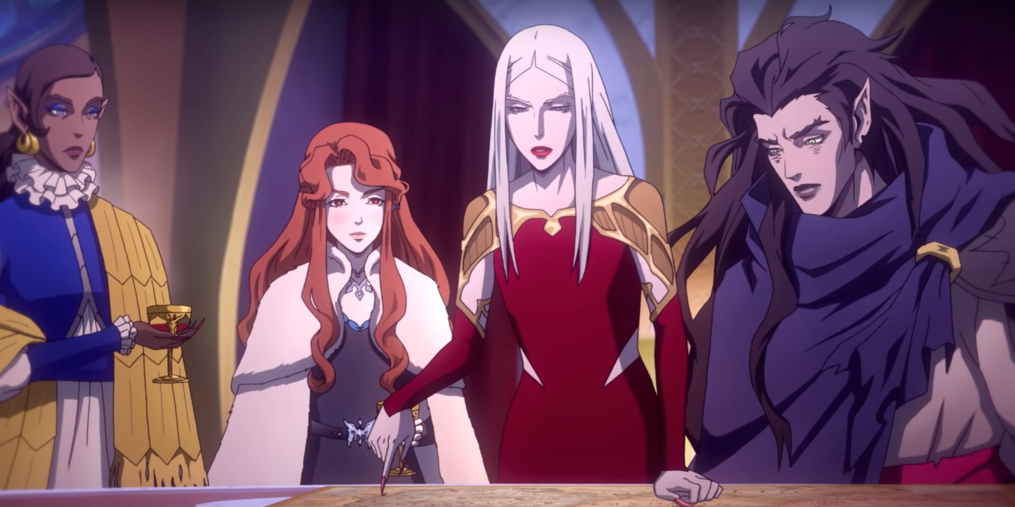
Hector, Carmilla, Striga, Morana, and Lenore
After a month of travel on foot, Carmilla and the last of her troops arrive at Styria, with Hector in tow. Hector’s been badly beaten and treated worse than a dog. Carmilla is greeted by Striga, Morana, and Lenore, the other three queens who rule Styria.
To be honest, alongside Isaac, Carmilla was one of my least favorite characters of season two, despite having the best one-liners. This season has totally brought me onto her side. Seeing her interact with her sisters is a great way to dampen her intensity and you can see why the other three call her the spark of their quartet.
After Dracula’s absence, the land has been in chaos. There are night creatures everywhere, people are fighting, vampire bands are all vying for power in the vacuum. Carmilla sees an opportunity for them to capture the eastern land that has been suffering upheaval after Dracula’s actions and turn it into a livestock pen of humans for vampires to feed on. Because their forces have been depleted, she wants to use Hector to forge night beasts that can patrol the borders of the corridor nation.
Unfortunately, she’s been beating and abusing Hector, locking him up naked and feeding him molded food. And because night creatures obey the forge master, and forge masters can only be human, they could be giving him an army of his own. The queens need Hector’s loyalty, so Lenore, the diplomat, decides to take on the project of earning his loyalty.
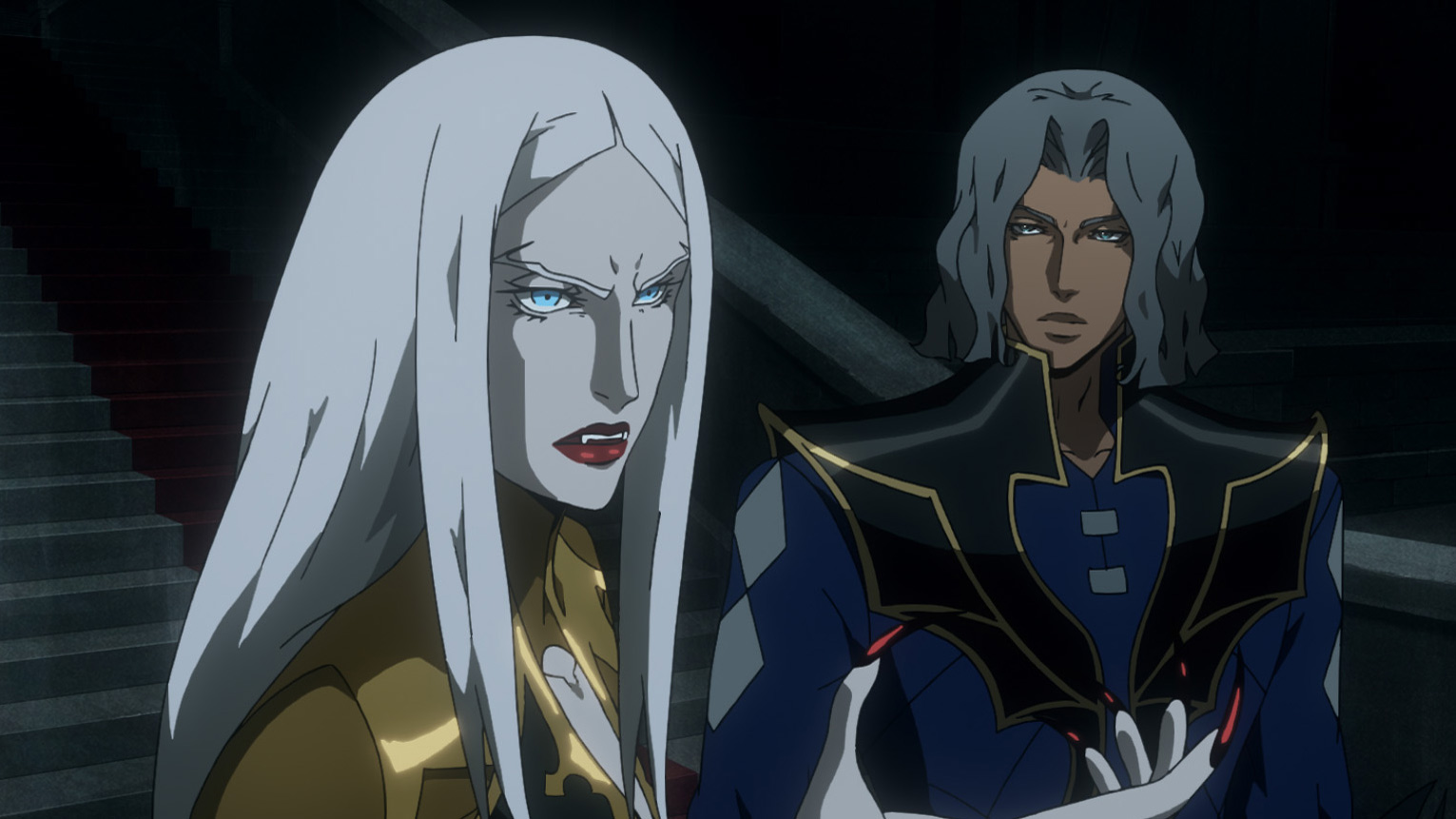
Although she appears to be the most soft-spoken of the sisters, Lenore proves quickly that she is not to be trifled with when Hector tries to take advantage of her and escape and she beats the living hell out of him. As the diplomat, she is a queen of manipulation and slowly starts to feed Hector the idea that what they want is the same as what Hector wanted with Dracula.
Unlike Dracula, they don’t want to kill all humans. They want a cull, just like Hector. Dracula lied to him, and even though Hector seems begrudged to sully Dracula’s name, Lenore’s words start to make sense. She brings him food, gives him clothes, offers to pay for his work, and even shows him some kindness, but she is undoubtedly molding him for their control.
While she works on Hector, Morana and Striga think about the logistics of Carmilla’s plan. Morana, the organizer, seems to be warming to the idea, while Striga, the warrior, worries that Carmilla is getting caught up in her own ideas. The two are clearly in a romantic relationship together and it’s nice to see these two powerful women, who aren’t necessarily good people, genuinely devoted to one another.
I’m very curious to see how the quartet’s story plays out because their history seems so interesting and their loyalty to one another is admirable. Understanding Styria’s ruling quartet puts Carmilla’s actions and words in the previous season in a clearer light. If they’re trying to bring down the patriarchy, I can’t help but admire them a little. Also yes to ruling vampire lesbian queens.

Trevor, Sypha, and Lindenfeld
Of course, my favorite storyline this season has been following Trevor and Sypha. The two have the best rapport (with Alucard they have even better rapport, but unfortunately he’s stuck at the castle) and are clearly enjoying their time as monster hunters and adventurers. They’re both changed for the better since embarking on the journey together, and the shipper in me is so happy to see them as a ridiculously cute couple.
(Bring back the OT3, but also I’m okay with Trevor and Sypha keeping each other warm and bickering back and forth.)
They arrive in the small town of Lindenfeld and are immediately embroiled in the local drama. They meet characters like the Judge of Lindenfeld, Prior Sala and the men of his priory, and Count Saint Germain, a curious stranger who happens to be a magician and an immortal? Originally only intending to stop for the night, it doesn’t take long for Sypha and Trevor to realize there’s something afoot in the town.
During a night creature attack before, the town was destroyed and the priory attacked and invaded by a giant night creature. Instead of killing the men inside the priory, the monster spoke to them, and afterward, the monks couldn’t stop crying. The Judge, the leader of the town, views them as “broken” and, after learning who Sypha and Trevor are, want the two of them to investigate what happened at the priory.
The men of the priory give off mad cult vibes. And after a few interactions, it’s clear they are almost satanic in nature. After it was revealed that the church was the cause for Dracula’s crusade, since they killed his wife, the priory seems to be shaken to its core. They want to find and punish the people who killed Dracula because they believe in Dracula’s mission.
Because of this interest in Dracula, Prior Sala allows Saint Germain to come through the priory doors and study in their library, even though no one is allowed in the priory and many parts of the building are off-limits. Inside, the carving of Jesus on the cross has been inverted and the symbol the priests all wear is the alchemical symbol for sulpher, used by philosophers to denote hell.
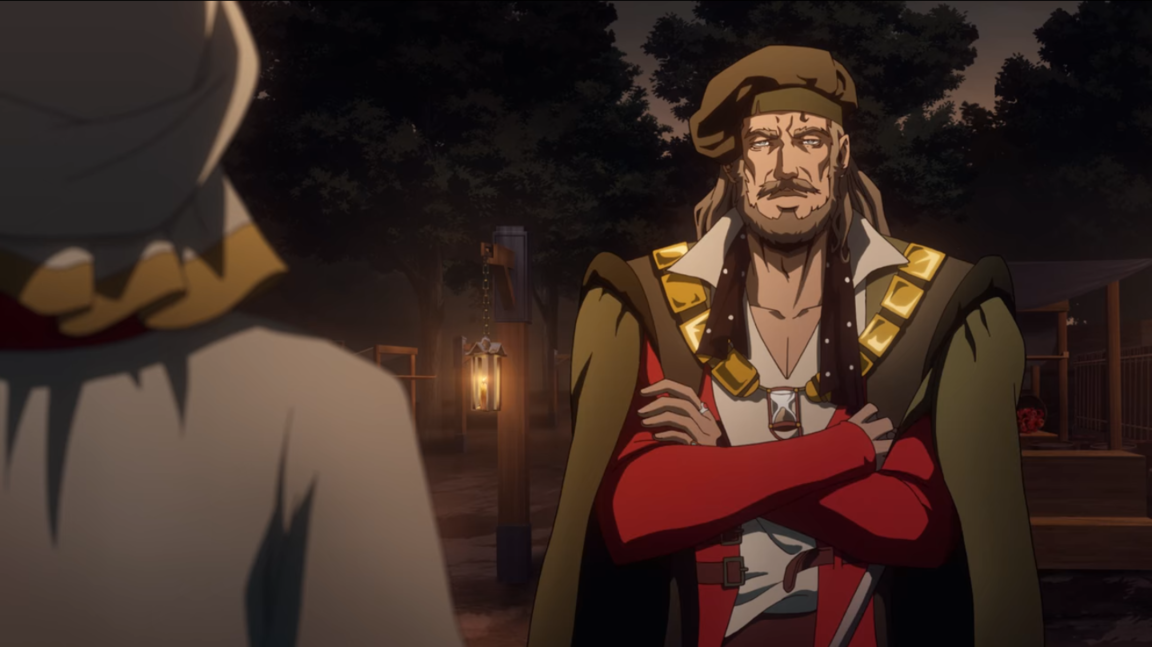
The Prior has a pretty demented view of God’s plan — one that Isaac probably would agree with — and becomes clear to Saint Germain that they might be hiding something beneath their priory. After discovering the symbol for Saturn carved on a building’s wall, both Sypha and Saint Germain seem concerned. The symbol can stand for lead, which denotes transformation and redemption, while it can also stand for the scythe, which denotes time and harvest. Both seem non0threatening until ou put it in the light of the priory.
Pulling Trevor and Sypha aside, Saint Germain reveals the real reason why he is in Lindenberg. He is looking for something called an infinite corridor. It is a pathway to other lands separated by space and time, sometimes this can lead to hell or different levels of hell, or to other worlds. Saint Germain possesses a stone that he has enchanted with Lithomancy to guide himself to the corridor and all signs point to the priory. Both Sypha and Trevor believe that the night creature that attacked the priory did not do it on accident and came to the town in search of the corridor.
There’s still a lot unknown about Saint Germain, but he is an interesting character. He seems to be from a family of monster hunters, or familiar with the concept of magic and the occult at least. He tells Sypha and Trevor that he is looking for someone who is lost in the corridor and the reason why he is here is that the portals are few and far between, often drifting in and out of existence.
One of the best things about this season is the balanced storylines we get. Everyone’s story is interesting or compelling. I find myself excited whenever the episode switches geras and we go from Styria to Lindenfeld to Dracula’s castle to Genoa. I can’t wait to see what the second half of the season has in store and whether we’ll see all the characters in the same place by the end of it.
Also, will we ever meet the pirate of the road that pushes a sailboat on wheels?
Castlevania season three is streaming now on Netflix.